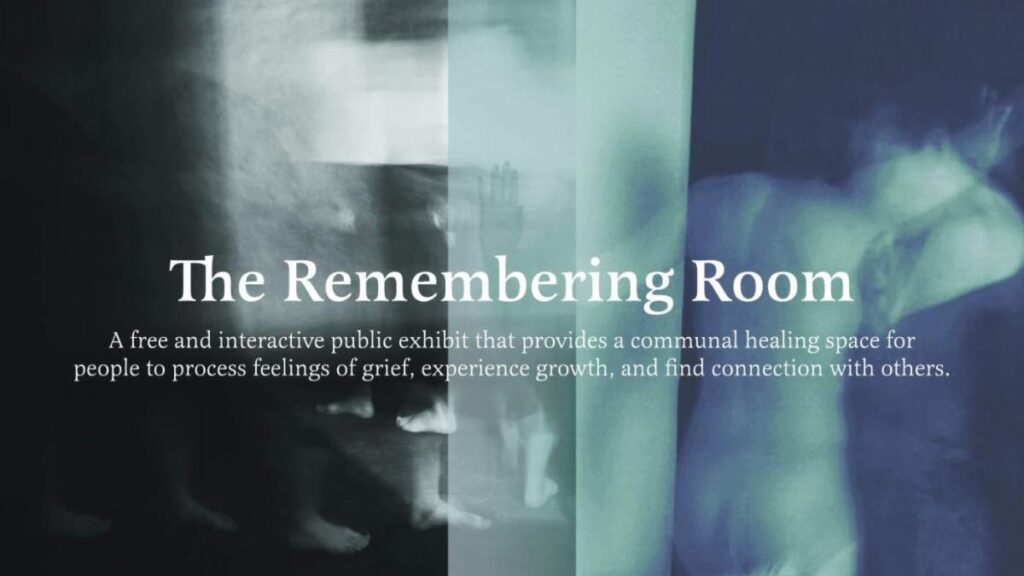
It was a Saturday, the first in a long time, when I wasn’t out of town, or too tightly scheduled to consider a variation in the day’s routine. I put the regional newspaper in the front seat of my car when I left for my exercise class, thinking that, after class I’d try to find the interactive art installation featured on its front page. “The public exhibit that provides a communal healing space for people to process feelings of grief” was at the Atithli Studios, (which I’d never heard of). The space turned out to be “a one stop shop for artists…a gift to the artist community of Pittsburgh–respite for the artist soul.” Art of Grieving advocate that I am, I couldn’t resist. It was less than three miles from my home.
As a dancer and director of the InterPlay-based improv troupe, The Wing & A Prayer Pittsburgh Players I felt immediately welcomed by the large open space, the studio’s bright high ceiling and natural wood floor. As I spoke to the manager, I could imagine movement and improv storytelling presentations and workshops happening there.
The Remembering Room art instillation by author Amanda Fillippelli is a few steps off the main space. A table with flyers that described it’s origin and purpose invited me to enter and partake of an experience the artist calls “Surreal,…a place we go when words simply can’t capture meaning, where our interior experience expresses itself.” It’s not mentioned in the flyer, but on her website, we learn that not quite a year ago, when her 61-year-old father didn’t show up to pick her mother up from work, she went by his home to check on him and found him dead. Two weeks after his death, she learned she was pregnant with her first child. Knowing this backstory helps to explain the unusual brilliance of Fillippelli’s understanding and articulation of grief and what’s needed to process it.
I agree with Amanda that when we are given much loss, it is part of our grieving that we need to channel it into something useful we can share. My most profound experiences that required grieving, –accompanying my best friend, my son, my daughter, though their illnesses and deaths, came with months or years of warning rather than the trauma of sudden loss. As a dancing social worker, I turned to writing, dancing and other art processes to grieve, eventually writing my story in the book, Warrior Mother, Fierce Love, Unbearable Loss, and the Rituals that Heal.
Encountering the enormous resistance to grief so common in our culture, while promoting that book, I was led to spend the last several years working on an upcoming book, “The Art of Grieving: How art and artmaking help us lead our best lives now.” Given my backstory, you can imagine my excitement and joy in discovering and traversing Amanda’s four remembering rooms.
In the first room named Desert, I’m invited into silence. I follow the instructions to select something I am currently grieving, tear out a piece of paper from a notebook and write the name of my grief on it. Rather than a person, I select a loving relationship that has broken my heart. The center of the second room contains a mannequin in a bathtub. The silence is broken by a mixed audio tape reading excerpts from Amanda’s poems. Looking into the tub I become aware of my own skin underneath my clothing. Invited to, I write a note to one of my deceased children.
The third room is called Grief’s Womb, and I’m grateful to see the large opening in the sculpture of a tree/woman’s body partially filled with notes that others have placed there before me. I eagerly fold mine and place it there. Underlining that action, I notice I take a deep exhale.
Entering the 4th room, I’m reminded of lighting candles in a church, the space feels sacred. Walking around the boat in the center reminds me of the song, an African American spiritual, “Michael Rowed the Boat Ashore.” I’ve used sung lines from that spiritual in my own rituals to separate yet connect grief stories.
Leaving the rooms I buy Amanda’s book, The Remembering Room, available for purchase on the welcome table. I look forward to its wisdom which I know goes beyond her years, but not beyond her experiences, insights, and skills. The back cover carries a brief poem/note,
“Dad–
only in the breaking of time
can we see that everything
is already in the past.
I grieve for you, but
there is joy at the end of this.”
If you live in the Pittsburgh area, don’t miss this exhibit which is open until April 16, 2023, at the Atithi Studios, 1020 N Canal St. Sharpsburg, PA 15215. If you are interested in experiencing this instillation while connecting with others, send me an email and we’ll see about organizing a field trip to the site sometime on a Saturday before it closes.

